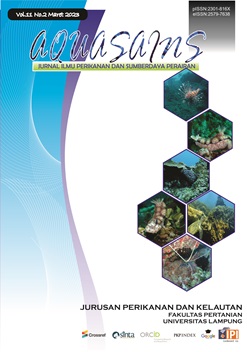QUALITY OF SHRIMP CRACKERS WITH ADDITIONAL INGREDIENTS OF BLUE SWIMMING CRAB (Portunus pelagicus) WASTE PRODUCT, LEMI
DOI:
https://doi.org/10.23960/aqs.v11i2.p1333%20-%201342 Abstract View: 198
Abstract View: 198
Abstract
The purpose of this study was to determine the difference in the quality of crabs from the addition of crab mustard in the manufacture of shrimp crackers, increasing the usefulness of crab mustard which are generally discarded and can be used as processed cracker products. The use of crab mustard in this study as an additional ingredient in the manufacture of shrimp crackers. Quality parameters in the form of nutritional composition include: protein, fat, carbohydrate, water and ash, organoleptic test (texture, taste, smell and color) and Total Plate Count (TPC). Experimental method, analysis of data by F test on product quality with 5 treatment composition comparisons: flour, mustard and shrimp meat, namely: L (50%: 50%:0%); A (50% : 37.5% : 12.5%); B (50% : 25% : 25%); C (50% : 12.5% : 37.5%); U (50% : 0% : 50%), each treatment had 3 replications. The results of proximate analysis (protein, fat, carbohydrates, water and ash), organoleptic test showed a very significant difference (P<0.01) between treatments, but for TPC there was no significant difference (P>0.05). The best nutritional composition in treatment C. The best organoleptic test results in treatment C. The best TPC value in treatment A.
Downloads
References
Anggit, P., Darmanto, Y. S., & Swastawati, F. (2011). Analisa mutu satsuma age ikan kurisi (Nemipterus sp.) dengan penggunaan jenis tepung yang berbeda. Jurnal Saintek Perikanan, 6(2), 13–22.
Deborah, T., Afrianto, E., & Pratama, R. I. (2016). Fortifikasi tepung tulang Julung-julung sebagai sumber kalsium terhadap tingkat kesukaan kerupuk. Jurnal Perikanan Kelautan, 7(1).
Engelen, A., & Angelia, I. O. (2017). KERUPUK IKAN LELE (Clarias sp) DENGAN SUBTITUSI TEPUNG TALAS (Colocasia esculental L. Schoott). Jurnal Technopreneur (JTech), 5(2), 34-â.
Hariyani, M. P., & Nunuk, I. (2018). Kerupuk Lemi Bebas Boraks Kajian Dari Dosis Natrium Tripolyphospat Yang Berbeda.
HASIM, N. (2016). PEMANFAATAN IKAN NILA (Oreochromis niloticus) DALAM PEMBUATAN KERUPUK BERBAHAN DASAR TEPUNG SAGU (Metroxylon sp.). Skripsi, 1(632411110).
Jumiati, J., Ratnasari, D., & Sudianto, A. (2019). Pengaruh Penggunaan Ekstrak Kunyit (Curcuma domestica) Terhadap Mutu Kerupuk Cumi (Loligo sp.)[Effect of Using Turmeric Extract (Curcuma domestica) on The Quality of Squid Crackers (Loligo sp.)]. Jurnal Ilmiah Perikanan Dan Kelautan, 11(1), 55–61.
Jumiati, Rahmaningsih, S., & Sudianto, A. (2021). Mutu kerupuk limbah insang ikan kurisi (Nemipterus japonicus). Jurnal Teknologi Pangan, 15(1), 1–11.
Kamari, A., & Candra, K. P. (2017). Pengaruh substitusi ikan bulan-bulan (Megalops cyprinoides) dan lama pengukusan adonan terhadap kualitas kerupuk ikan. Jurnal Teknologi Pertanian Universitas Mulawarman, 12(2), 39–44.
Kusumaningrum, I., & Asikin, A. N. (2016). Karakteristik kerupuk ikan fortifikasi kalsium dari tulang ikan belida. Jurnal Pengolahan Hasil Perikanan Indonesia, 19(3), 233–240.
Mahfuz, H., Herpandi, H., & Baehaki, A. (2017). Analisis Kimia dan Sensoris Kerupuk Ikan yang Dikeringkan dengan Pengering Efek Rumah Kaca (ERK). Jurnal FishtecH, 6(1), 39–46.
Mudaningrat, A., & Ramdan, K. (2020). Kerupuk lemi Portunus pelagicus sebagai solusi pengelolaan limbah rajungan di wilayah Cirebon. Prosiding …. http://research-report.umm.ac.id/index.php/psnpb/article/view/3408%0Ahttp://research-report.umm.ac.id/index.php/psnpb/article/download/3408/3330
Mudaningrat, A., Ramdan, K., Salsabila, M., Aisyah, S., & Umami, M. (2020). Kerupuk lemi Portunus pelagicus sebagai solusi pengelolaan limbah rajungan di wilayah Cirebon. Prosiding Seminar Nasional Pendidikan Biologi.
Nugroho, T. S., & Sukmawati, U. (2020). Pengaruh metode pengeringan kerupuk udang windu (Paneaus monodon) terhadap daya kembang dan nilai organoleptik. MANFISH JOURNAL, 1(02), 107–114.
Nurainy, F., Sugiharto, R., & Sari, D. W. (2015). Pengaruh Perbandingan Tepung Tapioka dan Tepung Jamur Tiram Putih (Pleurotus Oestreatus) terhadap Volume Pengembangan, Kadar Protein, dan Organoleptik Kerupuk.[Effect of Tapioca and White Oyster Mushroom (Pleurotus oestreatus) Flour on Expansion Volume, P. Jurnal Teknologi & Industri Hasil Pertanian, 20(1), 11–24.
Rahmayani, A. A., Kadirman, K., & Caronge, M. W. (2016). Pengembangan Produk Kerupuk Udang Melalui Substitusi Tepung Ubi Jalar Ungu (Ipomoea Batatas Lam) Dengan Variasi Lama Penggorengan. Jurnal Pendidikan Teknologi Pertanian, 2(2), 135–148.
Ryo, M., Putra, A., Nopianti, R., Program, H., Teknologi, S., Perikanan, H., & Pertanian, F. (2015). Teknologi Hasil Perikanan Fortifikasi Tepung Tulang Ikan Gabus (Channa striata) pada Kerupuk sebagai Sumber Kalsium. FishtecH-Jurnal Teknologi Hasil Perikanan, 4(2), 128–139.
Setiyorini, E. I. (2013). Pengaruh penambahan udang rebon dan jamur tiram terhadap hasil jadi kerupuk udang rebon. Jurnal Tata Boga, 2(1).
Suryaningrum, T. D., Ikasari, D., Supriyadi, S., Mulya, I., & Purnomo, A. H. (2016). Karakteristik kerupuk panggang ikan lele (Clarias gariepinus) dari beberapa perbandingan daging ikan dan tepung tapioka. Jurnal Pascapanen Dan Bioteknologi Kelautan Dan Perikanan, 11(1), 25–40.
Wulandari, A., Waluyo, S., & Novita, D. D. (2013). Prediksi umur simpan kerupuk kemplang dalam kemasan plastik polipropilen beberapa ketebalan. Jurnal Teknik Pertanian Lampung, 2(2), 105–114.
Zulfahmi, A., Swastawati, F., & Romadhon, R. (2014). Pemanfaatan Dagingikan Tenggiri (Scomberomorus Commersoni) Dengan Konsentrasi Yang Berbedapada Pembuatan Kerupuk Ikan. Jurnal Pengolahan Dan Bioteknologi Hasil Perikanan, 3(4), 133–139.

.png)










